#Native Plant Identification
Text
5 Tips On Recognizing Potentially Toxic plants

- Examine flowers and fruits carefully. Some toxic plants have brightly colored parts to deter animals, while others may have berries that are tempting but dangerous.more
#Flowers and Fruits#Leaf Characteristics#Be Wary of Look-Alikes#Native Plant Identification#Exploring and identifying local native plants#Research Local Flora
0 notes
Text
It so annoying when people constantly misidentify normal sumac as poison sumac and tell you to pull them up or mow them. These people are depriving you of a berry that naturally tastes like pink lemonade/sweet tarts!
These pictures below are of the edible sumacs you might find. All three of them are different and all three of them are safe. They are Smooth Sumac, Rough Sumac, and Shining Sumac respectively.
There is even more rare native species of sumac but basically if they have red berries and flowers like the other three that's a decent way to identify them in the field.



Here below is a picture of Poison Sumac. It's more so related to poison ivy I believe (not a relative of normal sumacs!)
The flowers and berries are off white and droop downward which makes it easy to identify from afar.
It sucks that when you Google poison sumac Google will show you pictures of harmless native sumac and not these guys.
Poison sumacs look completely different and with a little plant education you will easily be able to tell the differences.


I'm summoning @lostinthelegs since they love sumacs and know way more than me.
187 notes
·
View notes
Text
Cane/Bamboo Adventures Part 1/?
So we just moved into a new house and there's this huge thing in the very back of the yard along a creek that I thought was bamboo, then I thought it was cane, and then after checking as many cane ID posts and videos I could find, I'm still completely unsure. My friend who's a wildlife student says it doesn't look like bamboo to her, but we both agree it doesn't look like the cane we've seen around South Georgia. She said it must be Arundinaria gigantea because no other cane gets this large, but all the cane we've seen identified as A. gigantea doesn't look like this. Here's my notes and some pics.
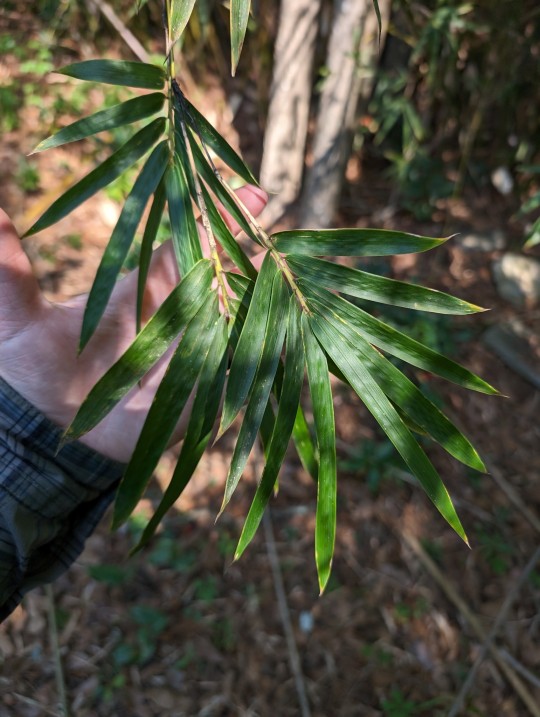
First, the leaves are much smaller than cane I've seen around here. Even very small, young cane around here has leaves about the length of my forearm.
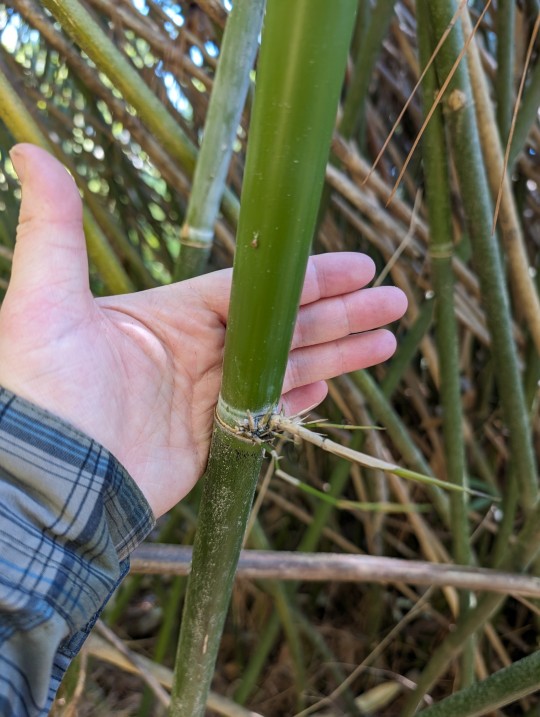
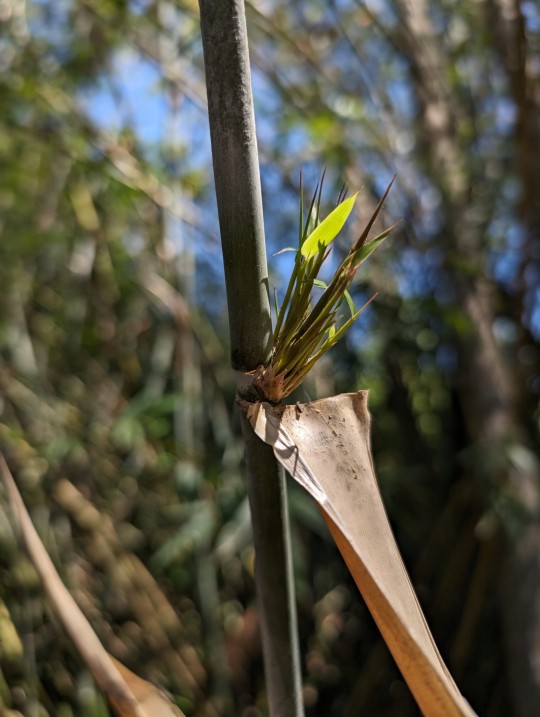
Second, a couple things online I found distinguishing bamboo from cane say that new bamboo branches grow outward, while cane grows more upward. However there seems to be both upward and outward shoots on this bunch (examples of both pictured above). Also worth noting, the picture above on the left is the biggest diameter branch I found. I have relatively small hands for context (I wear small-medium sized gloves).
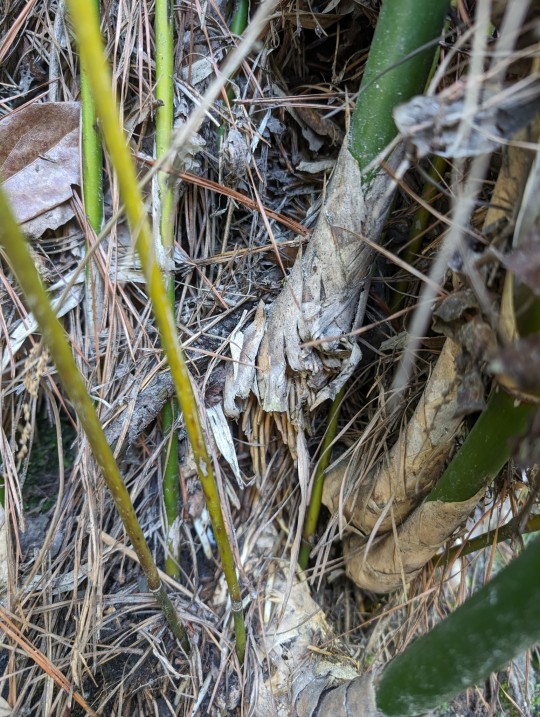
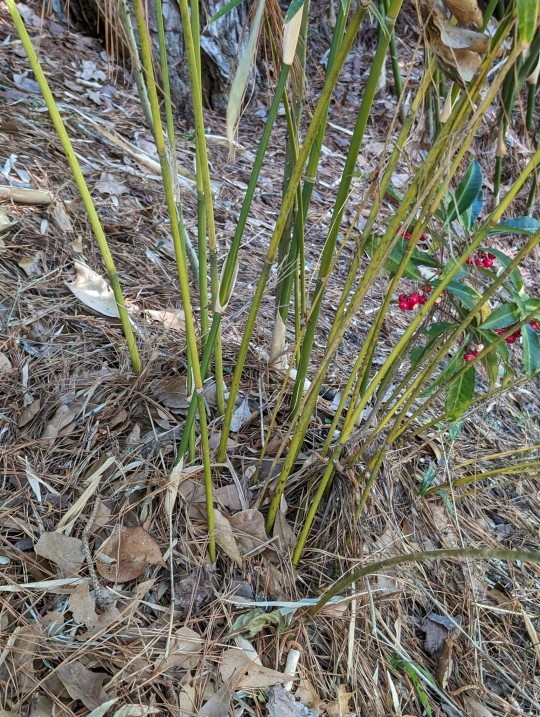
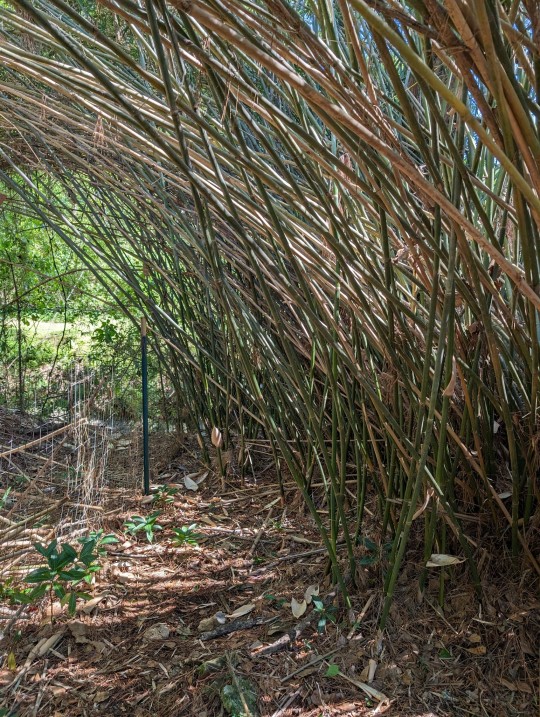
Then here's just some more pictures. I crawled down into a creek for the root picture (left)(a steep 7 foot drop haha). The middle picture is the youngest bunch I found, again it doesn't resemble cane I've seen around here. The picture on the right is a further away picture after I cleared some dead branches.
Also worth noting, this is tucked behind a house, between a fence, a creek, and like 3 trees. So it doesn't have a ton of space to grow, and I'm guessing that's why it's so dense.
If anyone happens to know anything about this please let me know! A week or so ago I emailed a guy from NC State and uploaded it on inaturalist, but I haven't received any replies or ID 😭
#I'm working on clearing out all the dead branches currently to give it more space#native plants#bamboo#cane#river cane#plant identification#plant ID#arundinaria gigantea#?#solarpunk
289 notes
·
View notes
Text

y’all know what this is?!
it is a clump of jewelweed seedlings!
common jewelweed (impatiens capensis) is native to north america and likes to grow along waterways. in the summertime she grows lovely little orange flowers.
but my favorite thing about her is her sap! it’s great for topical use on irritated skin. i make salves out of it and other happy-skin plants every summer. AND anD if you apply the sap to an area of skin that’s been exposed to poison ivy, it can prevent the rash from developing.
OMG there’s a poison ivy preventative!? well. . . no. this is a more of a “i am in the middle of the woods and have no soap and water but i DO have this plant” situation.
the thing is, you have to have to apply the jewelweed sap almost immediately after exposure to urushiol (the itchy juice in poison ivy), and if you’ve been in contact with poison ivy for more than a few minutes – which most people are because they don’t recognize/notice it – then it’s DEF not going to work. urushiol is absorbed by the skin too fast.
it’s still a cool plant and it DOES reduce itchiness and irritation from dermatitis and bug bites. 🦟
#plants#plant identification#jewelweed#impatiens capensis#us native plants#plant facts#cool plants#medicinal plants#wildcraft#my photos
54 notes
·
View notes
Text
Tea Time: Fireweed
lf you’ve seen one fireweed, you’ve probably seen several. As an early successional species, growing in large numbers across a vast amount of space is kind of its thing. Any disturbance that leaves bare ground in its wake, such as a wildfire or a windstorm, gives fireweed the opportunity to colonize. It grows quickly and spreads via rhizomes, producing thousands of airborne seeds in the process,…
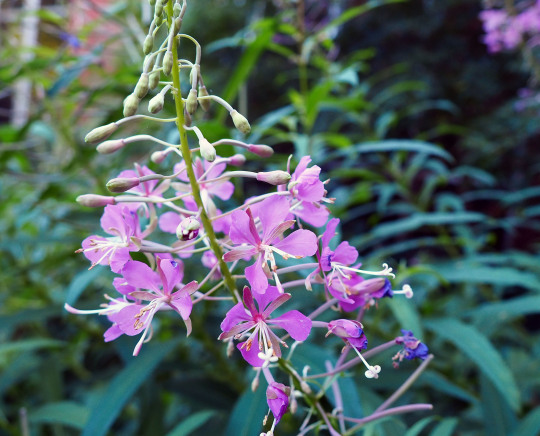
View On WordPress
#Chamerion angustifolium#Dispersal Stories#ecosystem services#ethnobotany#fireweed#flowers#foraging#leaves#native plants#Onagraceae#plant ecology#plant identification#rhizomes#rosebay willowherb#seed dispersal#tea#Tea Time
30 notes
·
View notes
Text
How to Identify Trailing Blackberry
Originally posted on my website at https://rebeccalexa.com/how-to-identify-trailing-blackberry/. Click here to learn more about the How to Identify article series.
Name: Trailing blackberry (Rubus ursinus), also known as California blackberry, Pacific blackberry, Pacific dewberry, and a number of other common names.
Range and typical habitat(s): West coast of North America from southern British Columbia to northern Baja California, east to the Cascade mountains, and scattered through the Rocky Mountains in Idaho, Washington, and Montana.
Distinguishing physical characteristics (size, colors, overall shapes, detail shapes): Summer is here, and that means blackberries are ripening on the vine! Here in the Pacific Northwest where I live we have multiple species, all featuring delectable, juicy berries, but only one is native. The trailing blackberry distinguishes itself through a slender, biennial vine, pale green to bluish-purple in color, with tiny thorns all along its length. (Be careful when handling this vine, as the thorns easily detach and become embedded in your skin!) Some vines may exceed six feet in length, and each plant may produce several of these from a central perennial root system.
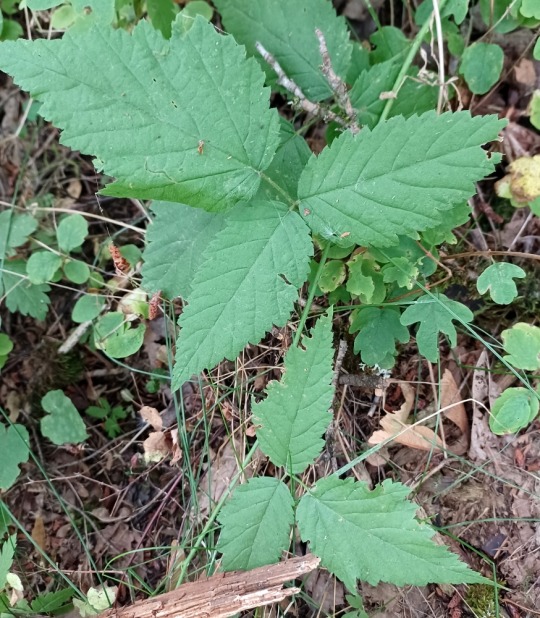
The leaves of trailing blackberry generally have three leaflets, though one or five may occasionally be seen, and they are dark green above with a pale green to white underside. Each leaflet is oval in shape with a pointed tip and a deeply serrated edge that has larger serrations interspersed with groups of smaller, finer serrations, and generally will not reach more than about four inches in length. This species is deciduous, and loses its leaves over winter before growing new foliage in the spring.

First-year vines are not fertile; they will not produce flowers until their second year, after which they die. Like many other Rubus species, it has a flower with five white petals that rarely exceeds an inch in diameter, and the petals are particularly slender compared to others in the genus. The center is pale green to yellow with several dozen anthers on the flowers of male plants. Female plants, of course, are the only ones to bear small berries about 3/4″ or so long at the largest, which start out green, darken to red, and finally ripen at a deep purple to black. While smaller than commercially available blackberries, they are quite sweet and flavorful when ripe. Technically they are not true berries, but are instead composites of several tiny round drupelets each with its own seed, which is typical of Rubus fruit.
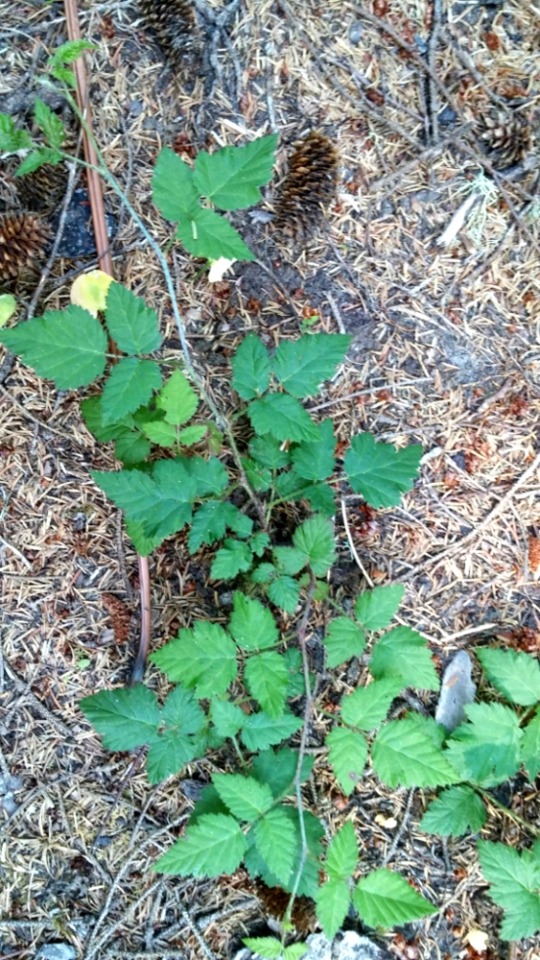
Trailing blackberry can grow quite quickly, and although it may clamber over other plants it generally does not out-compete them to the point of becoming a monoculture. It is also a quite hardy plant and can colonize disturbed ground with ease as long as there is plenty of sunlight. The vines can become a bit of a tripping hazard in places with high foot traffic, but are easily trimmed back without killing the entire plant. In addition to seeds, trailing blackberry can also grow colonies of clones wherever its vine touches the ground.
Other organisms it could be confused with and how to tell the difference:
In its native range, trailing blackberry is a rather unique little plant. It may occasionally be confused with the invasive Himalayan blackberry (Rubus armeniacus). However, the latter grows on large, thick canes up to thirty feet long that can grow tall and arch over, and which create massive thickets that choke out any other plant life. The leaves of Himalayan blackberry are also larger and rounder–up to eight inches long–and more typically have five palmately compound leaflets instead of three, though three leaflets may sometimes be seen. The flowers have rounder petals, and the berries are much larger, sometimes exceeding an inch in length.

Cutleaf or evergreen blackberry (Rubus laciniatus) is another invasive species found within trailing blackberry’s range. Like Himalayan, the cutleaf species also grows thick, long canes. It is mainly distinguished by its leaves, which have three leaflets that are deeply serrated/toothed and have a jagged appearance–hence the name “cutleaf.”

Black or whitebark raspberry (Rubus leucodermis) has berries which superficially look like those of trailing blackberry. However, once again the canes of this species are thicker and woodier than the trailing vines, and they have a distinctive white to pale purple glaucous coloration. The leaflets are larger than those of trailing blackberry, with first-year leaves having five pinnate leaflets, and second-year having three. The berries are larger and rounder, generally not exceeding 1/2″ in diameter. The overall appearance of the plant is of a taller, more upright shrub than a series of vines trailing over ground and other surfaces.

Anything else worth mentioning? Like other Rubus species, the berries of trailing blackberry are edible, and the leaves may be made into tea. If cultivating this species in your native plant garden, be aware it grows quite quickly, though it can be trained up a trellis with some effort.
Further reading:
Rubus ursinus – Trailing Blackberry
Rubus ursinus – Trailing blackberry; Dewberry; Pacific blackberry
Trailing Blackberry – Rosales Rosaceae Rubus ursinus
Trailing Pacific Blackberry
Did you enjoy this post? Consider taking one of my online foraging and natural history classes or hiring me for a guided nature tour, checking out my other articles, or picking up a paperback or ebook I’ve written! You can even buy me a coffee here!
#blackberries#berries#foraging#plant foraging#edible wild foods#plants#gardening#native plants#invasive species#invasive plants#Pacific Northwest#PNW#food#plant identification#nature identification
32 notes
·
View notes
Text
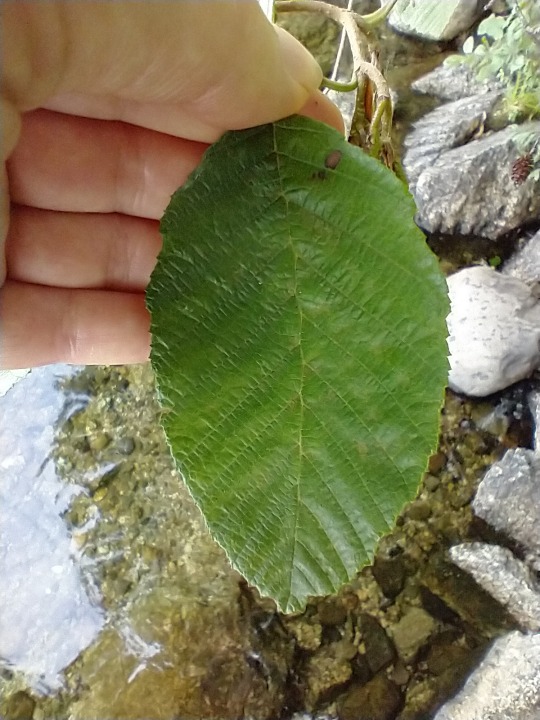

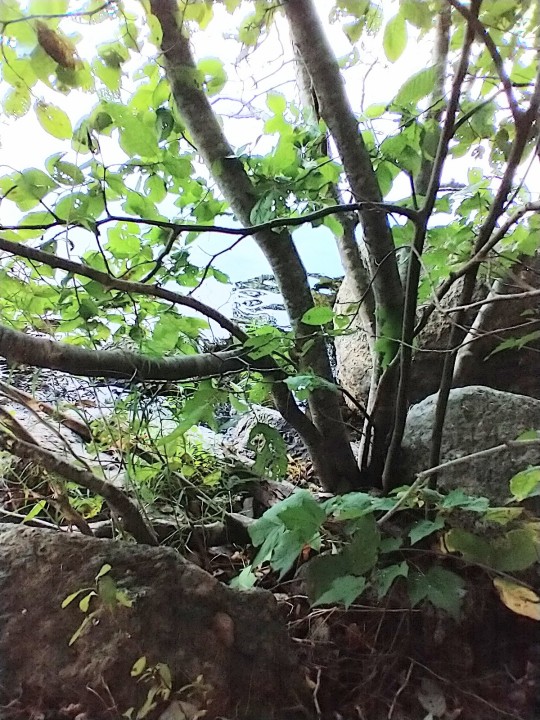

Hazel Alder
Location: Northeast shore of Phillips Lake, Dedham, Maine
Notes: this was a very difficult ID! This identification is based on leaf shape, cone shape, habitat, bark lenticels, leaf veins, and tree size.
Leaf shape was a rough match for several birch and many alder species. However, most had more serration or a different degree of roundness. The one characteristic these leaves had that stood out to me was that the major leaf veins did not visibly branch. They were very neat and well defined.
Hazel Alder is a perfect match for leaf shape, veining pattern, and degree of serration. The form of a woody shrub at the waters edge is consistent with hazel alder.
16 notes
·
View notes
Text



Checker lily! I’m always so happy when I can spot a plant I know that hasn’t bloomed yet; usually flowering plants are easier to pick out of the crowd of any other greens once they have their blooms, so I always like to play the game of trying to find them by leaf identification
#I’ve been getting really good at native lily identification this way#checker lily#native plants#native flowers#take a walk with me
3 notes
·
View notes
Text


Local Christmas fern growing on a steep hillside.
2 notes
·
View notes
Photo


Morning glory is often thought of as a nasty invasive, and in regard to Calystegia silvatica (right) that is absolutely correct.
However, we also have a native morning glory, which is pictured on the left! This is Calystegia sepium or hedge morning glory.
You can tell the difference by looking at the green parts beneath their flowers. These are called bracteoles, and the bracteoles on our native morning glory are narrow, usually not even touching. The invasive flower has overlapping bracteoles.
18 notes
·
View notes
Text



Ever since I started pulling up the common plantain and quack grass in a part of my yard more dwarf cinquefoil has been popping up! It was over 5 years ago (before I started pulling invasive plants) that I saw a single cinquefoil growing by chance, but it was slow growing so I kept mis-identifying it as common cinquefoil. But now that the non-native plants are gone it's popping up like crazy! I moved a few to another part of the yard since they were only in one specific area.
I have no idea what the grass around the 1st and 2nd photos are though! I can only hope it's native and I have an idea of what it could be but grass identification isn't my strong suit.
#native plants#dwarf cinquefoil#cinquefoil#grasses#plant identification#flowers#plant photography#been pulling up whole quack grass root systems to get rid of all those rhizomes#galconphi
1 note
·
View note
Text
LINK FEST: 28 MAY 2024
Links that may or may not be related to gardens, food, travel, nature, or heterotopias and liminal spaces but probably are. Sources in parentheses.
map: The World’s 100 Largest Islands, Side by Side (David Garcia/Vivid Maps). Also, a sortable list of the islands.
essay: Blue Notes #19: Is my marriage weird? An investigation (Mari Andrew/Out of the Blue).
I’m sorry, this is another paid…

View On WordPress
#cocktails#elderberry#elderflower#geography#giin#herbs#infusions#islands#Italy#link fest#linkfest#links#living together#map#mari andrew#marriage#marriage culture#Mt Etna#native plants#plant ID#seedling identification#solitude#superbloom#wildflowers
0 notes
Text
identifying wild plants in a very early stage of succession!
today i stopped by this big Mulch Pile and decided to see how many plants I could find growing in this one small area. the answer: way more than i expected!
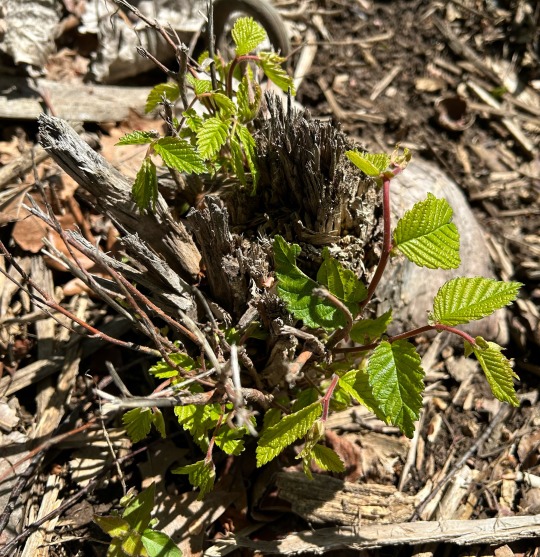

first i found what looks to be some kind of elm that got cut down but decided not to let that stop it. i also found a few different wild carrot patches. this one is next to some bur clover/burr medic (to the right) and stickseed (behind). the latter two plants are both new to me, so i'm not 100% confident on their identifications. corrections are always appreciated!
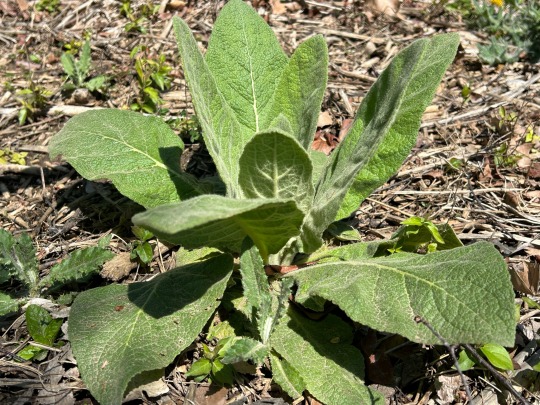

i also found two types of mullein! these plants will grow tall stalks full of flowers in the fall, and they get pretty big. i find them on the sides of highways and on the edges of cornfields. on the left is common mullein, which has very soft, fluffy leaves, and on the right is moth mullein.
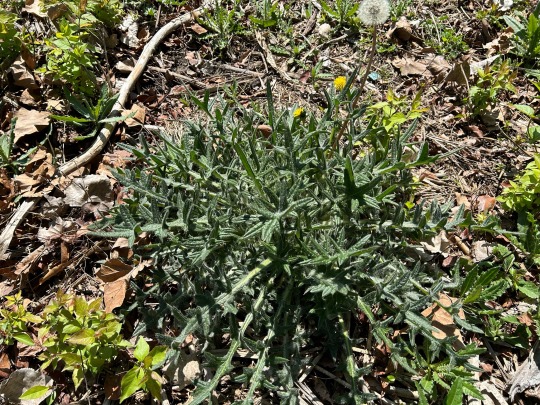
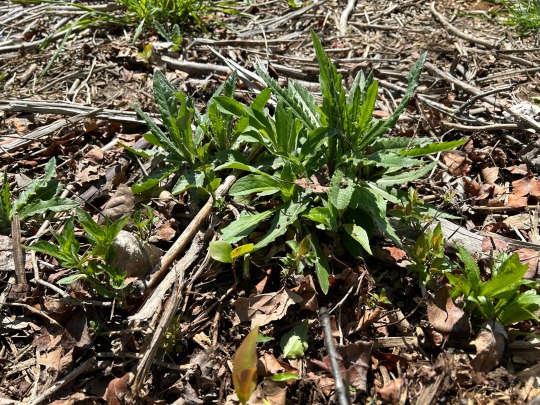
the field was absolutely COVERED in thistles. besides the honeysuckle, it was by far the most common plant growing there. on the left is a bull thistle, which takes up a very wide area. on the right, two creeping thistles are growing on either side of a daisy fleabane (one of my favorite plants ever :D) with some bittersweet nightshade at the front left and a very tiny boneset (another fall flower) at the front right.
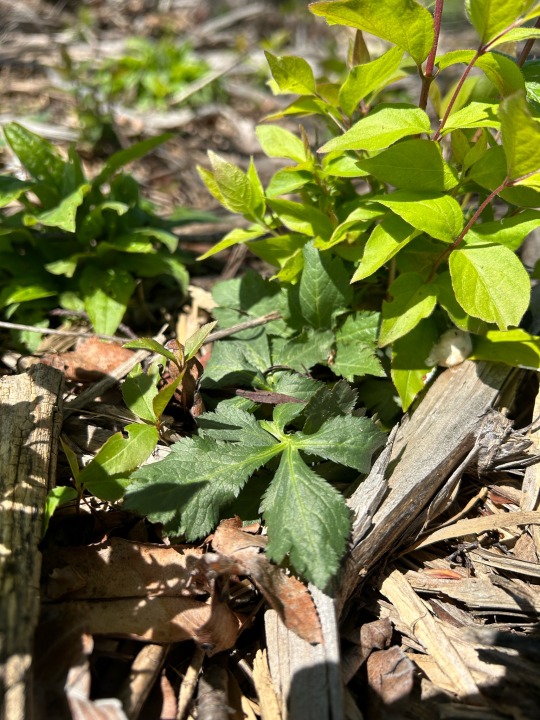
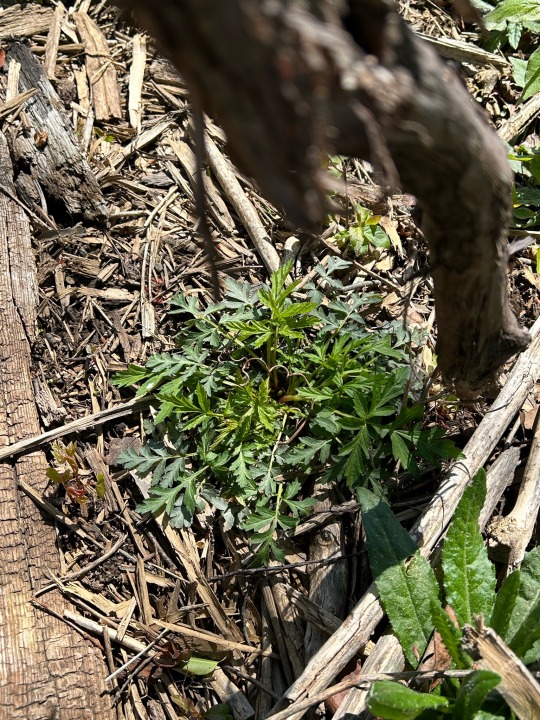
final two plants, both of which i'm not very familiar with: on the left is some black snakeroot i found beneath the honeysuckle, and on the right is white avens, hiding in the shadow of a thick grapevine stem—one of several stems that extends up to wrap around the black cherry tree above. there were several black cherries at the edge of this mulch pile, the only things that didn't get cut down in this small area. and i'm very glad they weren't, because i got to learn about a new native tree today as well!
there were still a few more plants i had yet to identify, or that were too small to really tell what they were, but i had already spent like half an hour sitting in this mulch pile staring and taking pictures, so i figured it was time to move on. i had a lot of fun and i was really happy to have correctly identified most of these by myself before checking! (i use an identifier app, which can be wrong from time to time but is a really useful starting point for unfamiliar plants.)
#native plants#plant identification#nature#errambles#aaand now i gotta tag all these plants. yippee#i dont think there's a way to make a tag system for specific plants that ISN'T a mess so i'll just keep doing whatever i want#elm#wild carrot#stickseed#medick#that's the bur clover btw. i'm just using its genus#mullein#i'm just using the names i think i'll remember fjkdlsafj im sorry </3#thistle#fleabane#nightshade#boneset#snakeroot#avens
0 notes
Text
Weed Witchery: Creeping Spurge

I’m on a mission to learn what all of these “weeds” in my parents’ backyard actually are. I think I’m gonna try to create posts sharing what I learn, as well as muse about how they could be incorporated in spells. And if anyone knows something I don’t about these plants, please share! I am not an expert. I’m just a lady reading Wikipedia and a few online field guides.
Quick Facts
Native to: North America
Edible: No
Cat/Dog Safe: No
Identification
Creeping spurge is also known as prostrate spurge because that’s the direction it grows. Instead of growing up, it grows out from a central taproot and stays low to the ground. There’s also a variety called spotted spurge because, you guessed it, the leaves have a big red spot in the center!

(Photo credit to inaturalist.org)
Now you may think this looks an awful lot like purslane, another so-called “weed” that’s loaded with nutrients. They both have thick reddish stems and pairs of small leaves that grow opposite each other. If you’re hunting for purslane to eat, be wary of this lookalike. Spurge is poisonous, do not eat it. Luckily, differentiating the two isn’t terribly difficult. First, are there flowers? Creeping spurge grows clusters of small pink-white flowers. Common purslane grows small yellow flowers.


(Photos obtained from https://www.minnesotawildflowers.info)
If there are no flowers, feel the leaves. Purslane is a succulent, so the leaves are thicker than, say, a leaf from a tree. If you’re still not sure, carefully pull a leaf off the stem. If white sap starts leaking out, it’s spurge. And that white sap is a skin irritant, so do not touch it.

(See that white dot in the yellow circle? That’s sap coming out from where I plucked a leaf. By the way, you probably shouldn’t touch things before you know what they are, a lesson I ignored why trying to identify this.)
Uses and Correspondences
Creeping spurge is a pioneer plant. This means that when an area is barren (such as after a wildfire or after being covered in pavement), this is one of the first plants to reclaim the land. To me, that screams “rebirth,” or “life after death.”
New beginnings can be good or bad. Given that it’s poisonous, I can see how spurge could be used for curses. Revenge spells in particular. Alternatively, a plant’s poison is its self-defense. This plant won’t hurt you if you don’t fuck with it. I bet if you handle it with care and respect (and gloves!!), it can serve as a feisty protective element to your spells.
#witchcraft#green witchcraft#native plants#gardens#plant identification#spotted spurge#Creeping spurge#purslane#common purslane#edible plants#poisonous plants#correspondence#magick#spellwork
1 note
·
View note
Text
How to Identify American Holly
Click here to learn more about the How to Identify article series.
Name: American Holly (Ilex opaca)
Range and typical habitat(s): Typically southeastern United States, from eastern Texas to the Atlantic coast, southern Missouri, and central Florida to scattered portions of New England. iNaturalist observations also place it in portions of Michigan, Illinois, Ohio, and Oklahoma, showing some expansion compared to the 2014 BONAP map, so its range may be expanding in response to climate change. In most of its range it is an understory tree growing in the shade of larger species. However, in Florida’s scrub habitat it grows as a shrub.

Photo by Derek Ramsay, GNU FDL 1.2
Distinguishing physical characteristics (size, colors, overall shapes, detail shapes): At first glance American holly looks quite similar to the European holly (Ilex aquifolium) so commonly used got holiday decorations (more about the differences between the two below.) It has medium to dark green oval-shaped leaves, sometimes with a yellowish tint, whose margins (edges) have concave curves between sharp points that are regularly spaced; large leaves may reach three inches long.

Photo by Famartin, CCA-SA-4.0-INTL
The American holly’s leaves have a leathery, stiff texture, and may appear waxy, and the underside is paler, often yellow in color. Each leaf has a central vein (midrib) that is depressed, appearing almost like a deep crease. Thinner veins branch off of both sides of the midrib. Some leaves may display smooth margins instead of the more typically spiky ones, especially when they are high enough to be out of the reach of browsing herbivores like deer.
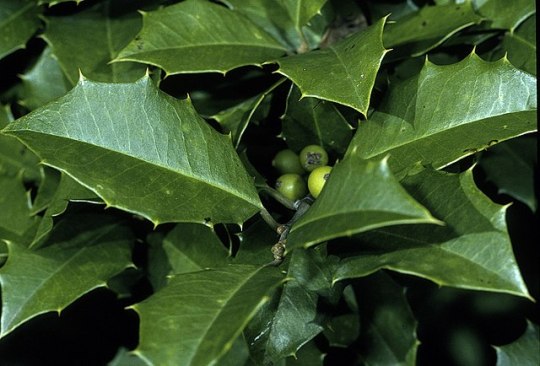
The foliage stays green throughout the year rather than being shed in fall; a given leaf may stay on the tree for up to three years before being displaced by a new replacement leaf. The leaves grow in an alternate pattern along a twig, with each leaf growing a little further along the twig than the last. The tree’s branches and trunk are covered in pale gray bark that is relatively smooth, but may have horizontal and vertical striations, along with various nodes and bumps, and might also play host to white patches of microlichen colonies. Other lichens, as well as mosses, also may add color to the American holly’s bark.
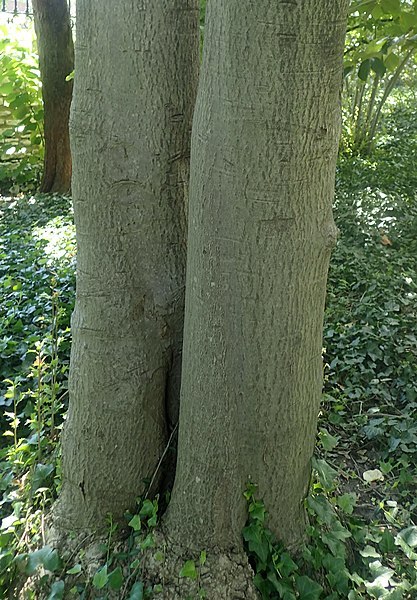
Photo by Krzysztof Ziarnek, CCA-SA-4.0-INTL
An exceptional specimen of American holly can reach almost 100 feet tall when mature, though it grows slowly. Such large trees are generally a century or more old, and the oldest on record was just a few years shy of 150.
The flowers of American holly are small (1/2″ or less across) with green centers and four (sometimes six) white petals that are broad with a rounded end, and whose tips curve back toward the plant. They grow in clusters of several flowers sprouting from one spot. American holly is dioecious, meaning that there are female and male plants; the males tend to reach sexual maturity a few years earlier than the females, but they all are generally reproducing by the age of ten.
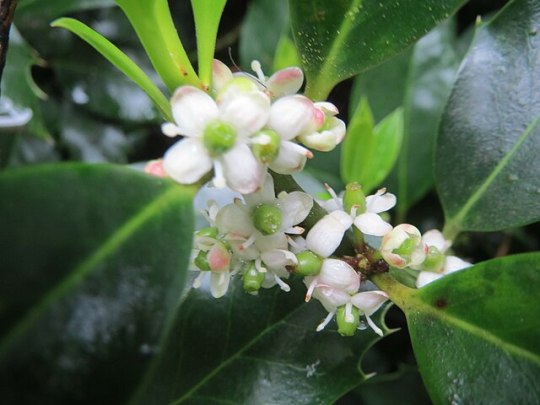
When fertilized by insects the female flowers then turn into the well-known red berries. Technically these are drupes rather than true berries, with four seeds apiece, and while they start out green they ripen to a bright red. The berries are popular with birds like cedar waxwings (Bombycilla cedrorum), but are toxic to humans and our pets.
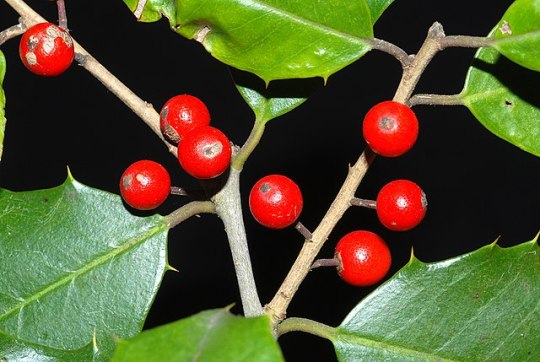
Photo by Douglas Goldman, CCA-SA-4.0
Other organisms it could be confused with and how to tell the difference: Due to their similarity, American holly and European holly may easily be confused at first glance, and both prefer the understory of a forest. However, the European species does not grow as large. The leaves of European holly are darker and have a glossier appearance; the edges may also be more warped where those of American holly lie comparatively flat. Moreover, European holly grows more commonly along the west coast of North America, and is more sparse throughout American holly’s native range, especially outside of cultivated spaces.

European holly (Ilex aquifolium)
Yaupon holly (Ilex vomitoria) is another species native to the southeastern North America, particularly the Gulf Coast states and the southern third of the Atlantic coast. It is a much smaller shrub that rarely exceeds thirty feet tall, and its leaves are round with serrated or scalloped edges rather than the pointed margins of American holly. The petals of the flowers may not curve as much as on American holly.

Yaupon holly (Ilex vomitoria)
Dahoon holly (Ilex cassine) also grows in the extreme southeastern United States, from Louisiana to the southern tip of North Carolina, and primarily along the coastline except in Florida where it can be found across much of the peninsula. Its leaves are longer and more slender than those of American holly, and the margins are almost entirely smooth except for a series of very small spikes.

Dahoon holly (Ilex cassine). Photo by Douglas Goldman, CCA-SA-4.0
Possumhaw (Ilex decidua) has long, slender leaves with a gently pointed tip and serrated edges. This deciduous plant drops its leaves in fall, unlike the evergreen American holly.

Possumhaw (Ilex decidua)
There are other plants that have similar leaves to American holly but that grow out of its range, such as the various species of Oregon grape (Mahonia spp.) in the Pacific Northwest, and holm oak (Quercus ilex), for which the genus Ilex was originally named.
Further reading:
USDA: American Holly
North Carolina Extension Gardener Plant Toolbox: Ilex opaca
Missouri Botanical Garden Plant Finder: Ilex opaca
Native Plant Trust: Ilex opaca – American holly
University of Connecticut Plant Database: Ilex opaca
Did you enjoy this post? Consider taking one of my online foraging and natural history classes or hiring me for a guided nature tour, checking out my other articles, or picking up a paperback or ebook I’ve written! You can even buy me a coffee here!
#holly#American holly#North America#native plants#Ilex#shrubs#plants#plant identification#nature identification#botany#trees#ecology#conservation#biodiversity#long post#nature#Yule#Christmas#holidays#scicomm
12 notes
·
View notes
Text


spotted this guy on a walk this morning. inaturalist says black mulberry morus indica. looks like it’s been cut down a few times so im tempted to try and rescue him
#im skeptical though i have native mulberries at home and this guy’s proportions look off to me#if you know what he is or isn’t pls feel free to lmk#plant identification#in the southeastern US
0 notes